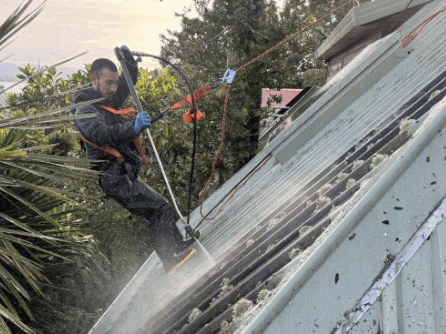Cleaning the roof may not be the foremost item on a homeowner’s maintenance checklist, yet pressure washing offers a multitude of advantages. This method effectively eliminates dirt, moss, and algae, which is vital for preserving the longevity of the home. It is essential to comprehend the safety measures, associated risks, and appropriate techniques related to pressure washing to prevent any potential damage. This article will examine the benefits of pressure washing, safety considerations, detailed step-by-step processes, and alternatives for maintaining the roof in optimal condition.

Why Pressure Wash The Roof?
Pressure washing the roof is a critical aspect of home maintenance that not only improves the aesthetic appeal of the property but also extends the lifespan of roofing materials. A clean roof can notably enhance curb appeal, making the home more appealing to visitors and potential buyers. Additionally, regular roof inspection and moss removal can prevent potential roof damage and highlight the importance of roof maintenance.
By utilizing a pressure washer and effective roof cleaning methods, homeowners can effectively eliminate stubborn stains, moss, and debris that accumulate over time, as these factors can contribute to roof damage and result in expensive repairs. Engaging professional services ensures that appropriate cleaning techniques are employed, thereby preserving the integrity of asphalt shingles while achieving a pristine finish. For comprehensive roof cleaning, it’s advisable to include techniques like soft wash and to consider periodic roof inspection.

What Are The Benefits Of Pressure Washing The Roof?
Pressure washing a roof offers numerous advantages that extend beyond mere visual improvements; it plays a critical role in maintaining the roof’s structural integrity, enhancing curb appeal, and prolonging the lifespan of roofing materials. By utilizing effective roof cleaning techniques such as high-pressure washing and soft wash methods, homeowners can efficiently remove accumulated debris, moss, and persistent stains that jeopardize the quality of asphalt shingles. Incorporating chemical cleaning and the use of specialized cleaning chemicals ensures a thorough cleanse while reducing the risk of water damage.
The application of specialized cleaning agents ensures a comprehensive cleanse without inflicting damage, thus making it an essential component of overall roof maintenance.
Regular pressure washing not only enhances the aesthetic appeal of a residence but also serves as a protective measure against significant damage caused by water pooling and algae growth, both of which can result in costly repairs if not addressed promptly. This process effectively eliminates contaminants that, over time, may deteriorate roofing materials and diminish their efficacy. Utilizing tools like a leaf blower can aid in removing debris before pressure washing to enhance the effectiveness of the cleaning method.
For instance, commonly used roof cleaning agents such as sodium hypochlorite or oxygen bleach can successfully eradicate moss and mold without harming the shingles. Including masonry cleaning techniques might also benefit areas with built-in stone or concrete features adjacent to the roof.
- Improving Roof Longevity: Regular maintenance through cleaning can potentially extend the lifespan of the roof, thereby avoiding premature replacements.
- Preventing Water Damage: A clean roof ensures proper water drainage from the surface, thereby preventing leaks and structural damage to the home.
- Enhancing Visual Appeal: A well-maintained roof contributes to an attractive exterior, thereby improving overall property value.
The significance of regular maintenance cannot be overstated, as it enables homeowners to proactively address potential issues, ensuring a safe and visually appealing living environment. This includes regular roof inspection for moss removal and prevention of water damage, which are essential aspects of sustainable home care.

Is Pressure Washing The Roof Safe?
While pressure washing can serve as an effective method for roof cleaning, safety is a paramount concern that every homeowner should carefully consider before proceeding with this task. The use of a pressure washer presents the potential risk of damaging the roof, particularly if improper techniques are employed, which may result in issues such as water leakage and damage to asphalt shingles. It is imperative to understand the safety protocols and best practices associated with pressure washing to ensure both the effectiveness of the cleaning process and the protection of roofing materials.
When undertaking roof cleaning, it is essential for homeowners to adhere to specific safety measures. Firstly, they should utilize appropriate pressure settings to prevent damage to the roof; generally, a pressure setting of approximately 1,500 to 2,000 PSI is recommended for asphalt shingles. Proper handling of the pressure washer is crucial to avoid accidental roof damage or water leakage.
Additionally, employing a suitable detergent for roof cleaning, applying it with a low-pressure nozzle, and using a ladder stabilizer to prevent slips can significantly enhance both safety and effectiveness. Homeowners must also remain vigilant regarding potential hazards such as slippery surfaces or flying debris, which can pose risks during the cleaning process. Incorporating cleaning chemicals that are safe for roofing materials can further reduce the chance of roof damage.
For those who may feel uncertain about managing this task independently, enlisting the assistance of professionals can provide reassurance. Professionals possess the expertise necessary to perform safe roof cleaning while ensuring optimal results, thereby safeguarding both the homeowner’s investment and their overall well-being.
Learn more: Will Pressure Washing Remove Deck Stain

What Are The Risks Of Pressure Washing The Roof?
Pressure washing the roof can be advantageous; however, it also presents several risks that homeowners should recognize in order to avoid costly errors and ensure safety. Improper techniques may result in damage to the roof, such as lifting shingles or creating leaks, which could require expensive repairs.
Moreover, the high-pressure water stream can pose a significant risk of personal injury if appropriate safety precautions are not observed. It is essential for homeowners contemplating this cleaning method to understand these risks to maintain the integrity of their roofs while safeguarding their own well-being.
Damage To Shingles
One of the primary risks associated with pressure washing a roof is the potential damage to shingles, especially when excessive pressure is applied. Asphalt shingles are engineered to withstand various weather conditions; however, the force generated by a pressure washer can dislodge or crack them, thereby compromising the overall integrity of the roof. It is imperative for homeowners to recognize the sensitivity of their roofing materials and to utilize appropriate pressure settings during the cleaning process to mitigate such damage.
Most manufacturers recommend maintaining a pressure setting below 1200 PSI when cleaning roofs. Failure to adjust the pressure adequately can result in the degradation of the granular surface of the shingles, which is essential for preserving their protective qualities.
Homeowners should be aware of the following risks associated with improper pressure washing:
- Loss of warranty: Many roofing manufacturers will void warranties if damage is incurred as a result of high-pressure washing.
- Increased water infiltration: Damaged shingles are susceptible to leaks, which can lead to further structural damage.
- Shortened roof lifespan: Consistent misuse of pressure washing can result in the premature deterioration of roofing materials.
Fortunately, alternative cleaning techniques can minimize these risks. For instance, employing a soft wash system, which utilizes low pressure in conjunction with specialized cleaning solutions, can effectively remove grime without causing damage to shingles. This method not only preserves the integrity of the roof but also proves to be more effective in achieving long-lasting cleanliness.
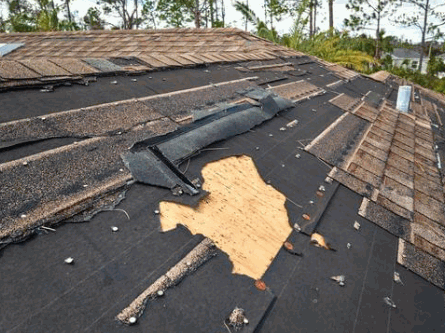
Water Leakage
Water leakage represents a significant risk associated with the pressure washing of roofs, particularly when improper techniques or excessive water pressure are employed. Should high-pressure water infiltrate the seams or slide beneath the shingles, it can result in leaks and subsequent water damage within the home. Therefore, homeowners must exercise caution during the cleaning process to prevent water from penetrating sensitive areas, which may necessitate costly repairs.
To effectively mitigate this risk, it is imperative to utilize appropriate methods and equipment during the cleaning process. Incorrect nozzle selection or positioning the pressure washer too close can lead to water entering vulnerable areas. Thus, employing effective pressure washing techniques and maintaining a safe distance from the roof is essential.
Homeowners can implement several preventative measures:
- Consider hiring professionals who are trained in proper pressure washing techniques, such as Trotta’s Power Washing.
- Ensure that the pressure washer is set to an appropriate PSI level for roof cleaning.
- Inspect the roof for any existing damage before commencing work.
- Apply sealing products to seams and shingles to establish a protective barrier.
By adhering to these guidelines, individuals can achieve a cleaner roof while minimizing the likelihood of water leakage and related damage.
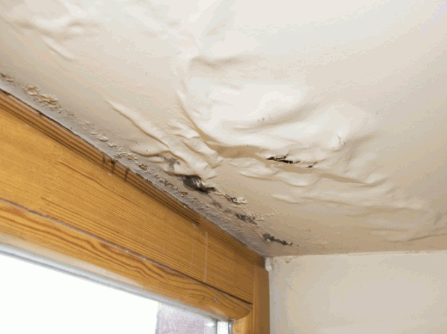
Personal Injury
Personal injury is a significant concern when pressure washing roofs, as the combination of height and high-pressure equipment can lead to accidents. Homeowners often underestimate the associated risks, which can result in falls from ladders or injuries caused by improper handling of the pressure washer. Implementing appropriate safety measures, such as using a ladder stabilizer and proper roof inspection, is essential when engaging in roof cleaning to mitigate these risks. Additionally, employing a leaf blower first can help clear the area of loose debris before pressure washing.
Before undertaking this task, it is crucial to observe several safety precautions. Homeowners in areas like Seattle or Mountlake Terrace should ensure they utilize a suitable ladder for roof access, as this significantly reduces the likelihood of falls. Additionally, wearing protective gear such as non-slip footwear, gloves, and safety goggles is advisable to prevent injuries from slippery surfaces and high-pressure spray.
- Establish a buddy system. Having an additional person present during the cleaning process not only provides extra support but can also be beneficial in case of an emergency.
- Take environmental conditions into account; avoid conducting the task on windy or rainy days, as these conditions can heighten the risk of accidents.
- If uncertainties arise at any point, it is prudent to enlist the services of professionals, as they possess the necessary expertise and specialized equipment.
Ultimately, prioritizing safety ensures that roof cleaning remains a manageable and efficient task, free from unnecessary risks.
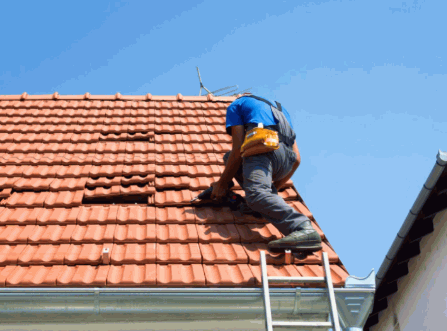
What Are The Steps To Pressure Wash The Roof?
Successfully pressure washing a roof involves a series of critical steps that ensure thorough cleaning while minimizing the risk of damage. This process provides homeowners with a clear roadmap for effective roof maintenance, especially when using high-volume equipment like those offered by Trotta’s Power Washing.
From preparing the area and selecting the appropriate equipment to employing the correct pressure settings and conducting a thorough rinsing, each step is vital in achieving optimal results. It is essential for homeowners to familiarize themselves with these procedures to maintain their roofs effectively and safely.
Prepare The Area
Preparing the area before pressure washing is essential to ensure a safe and effective roof cleaning process. This preparation involves removing obstacles and covering sensitive areas to prevent potential damage.
Homeowners should undertake several specific actions to adequately prepare their property. First, utilizing a leaf blower can significantly facilitate the removal of leaves, twigs, and other debris from the roof and surrounding landscape. This practice not only reduces the risk of gutter clogs during washing but also creates a cleaner workspace.
Furthermore, it is imperative to protect nearby structures, including windows and plants, by covering them with tarps or plastic sheeting. This precaution shields these areas from any unexpected splashes of water or cleaning agents.
- Double-check local regulations in areas such as Washington to determine if any permits are required for roof cleaning.
- Ensure that all electrical outlets and power sources are securely protected to avoid hazards.
- Consider the use of safety gear, such as gloves and goggles, to ensure protection during the cleaning process.
By implementing these preparatory steps, homeowners can ensure that the roof cleaning is both effective and safe for the surrounding environment.
Use The Right Equipment
Utilizing the appropriate equipment for pressure washing a roof is crucial for achieving optimal results while minimizing potential risks. The selection of inappropriate tools can lead to damage or ineffective cleaning outcomes. A suitable Pressure Washer, typically designed for high volume and pressure efficiency, is essential, complemented by additional tools such as a soft wash system for sensitive areas. This approach ensures optimal results without compromising the integrity of the roofing materials.
When selecting a pressure washer, it is important to consider two primary types: electric and gas models. Electric pressure washers are well-suited for lighter tasks and generally operate within the range of 1300 to 1800 PSI, making them ideal for gentle cleaning operations. Conversely, gas-powered models can achieve pressures exceeding 3000 PSI, providing the necessary power to tackle more stubborn stains and grime on roofing materials.
- It is advisable to consider a soft wash system for delicate roofing types, such as asphalt shingles or tile, where high pressure could cause damage.
- Additional tools, such as a surface cleaner attachment, can enhance efficiency and reduce the time required for cleaning.
- Furthermore, it is imperative to invest in safety gear, including goggles and non-slip footwear, to ensure protection during the cleaning process.
By selecting the appropriate equipment and employing effective techniques, one can achieve a thorough cleaning while preserving the integrity of the roof.
Start From The Top
Beginning the pressure washing process from the top of the roof is a critical technique that allows both water and cleaning solutions to flow downward. This method prevents the formation of streaks or residue on the shingles and ensures an even cleaning. Additionally, it mitigates the risk of water accumulation in areas that may lead to damage. Homeowners, such as those in Seattle, should approach this task methodically, working down the slope of the roof to maintain control and effectiveness throughout the washing procedure.
This technique is not merely for aesthetic enhancement; it is vital for preserving the integrity of the roofing material.
For those undertaking this task, achieving a comprehensive wash is essential and can be facilitated by implementing specific strategies:
- Utilize appropriate safety gear, including non-slip shoes and a harness, to prevent accidents. This gear is especially important for those emulating professionals like Justin Trotta in ensuring safe practices.
- Employ a pressure washer with adjustable settings to control the water pressure, thereby preventing damage to the shingles.
- Ensure the roof is dry and free from debris prior to washing to enhance the effectiveness of the cleaning solution.
To maintain balance while cleaning, it is advisable to work methodically, focusing on smaller sections at a time. By doing so, individuals can ensure thorough coverage without compromising their safety or the condition of the roof. For efficient cleaning, consider using eco-friendly cleaners that effectively break down dirt and algae while being gentle on the environment.

Use The Appropriate Pressure
Utilizing the appropriate pressure during the roof cleaning process is essential for effectively removing dirt and debris while minimizing the risk of damage to the roofing materials.
It is imperative for homeowners to understand that different roofing materials may necessitate specific pressure adjustments to achieve optimal results. For example, asphalt shingles, which are a common choice for many residences, can be particularly vulnerable; applying excessive force could result in significant issues, including cracks or the complete loss of shingles.
Consequently, professionals advise adhering closely to the manufacturer’s specifications to prevent any mishaps.
To determine the correct pressure, consider the following essential steps:
- Consult manufacturer guidelines for recommended cleaning pressures.
- Conduct a test on a small, inconspicuous area prior to treating the entire roof.
- Monitor the reaction of the material; if granules begin to detach, reduce the pressure immediately.
This approach not only enhances the effectiveness of the cleaning process but also extends the lifespan of the roof, thereby ensuring peace of mind and protecting one’s investment.
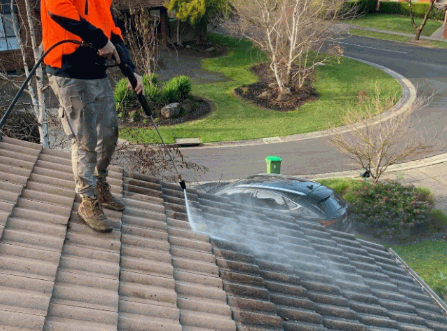
Rinse Thoroughly
Rinsing thoroughly after pressure washing is a crucial final step that ensures all cleaning chemicals, dirt, and debris are completely removed from the roof, thereby preventing potential damage or residue buildup.
To accomplish this, homeowners should prioritize the use of clean, fresh water during the rinsing process. It is advisable to begin rinsing from the top of the roof and proceed downward in a methodical manner to facilitate the runoff of dirt and chemicals.
Careful timing of the rinse is equally important; it is recommended to rinse promptly after applying cleaning solutions to prevent any drying that could result in hardened residues. After completing the rinse, it is beneficial to take a moment to inspect the roof for any remaining spots or streaks, as this thorough inspection ensures that all areas have been adequately addressed.
- Utilize a gentle, sweeping motion for uniform coverage.
- Begin rinsing at the highest point of the roof.
- Conduct an inspection for any missed areas following the cleaning process.
What Are The Alternatives To Pressure Washing The Roof?
Homeowners exploring alternatives to pressure washing their roofs will find options such as soft washing and chemical cleaning to be effective solutions that reduce the risks associated with high-pressure methods.
Soft washing employs low-pressure techniques in conjunction with specialized cleaning agents to safely eliminate dirt, moss, and algae without causing damage to roofing materials, making it particularly suitable for sensitive asphalt shingles.
Conversely, chemical cleaning utilizes targeted solutions to effectively break down stubborn stains, ensuring a comprehensive cleaning while maintaining the structural integrity of the roof.
Soft Washing
Soft washing is a roof cleaning method that utilizes low-pressure water in conjunction with specially formulated cleaning chemicals to effectively remove dirt, algae, and moss without causing damage to roofing materials. This technique is particularly advantageous for homeowners with asphalt shingles, as it provides a comprehensive cleaning solution without the harsh impact of pressure washing, thereby preserving the longevity and integrity of the roof.
In the application of this method, a variety of cleaning solutions are typically employed, including sodium hypochlorite, which serves as an effective agent for eliminating algae, and biodegradable surfactants that assist in lifting grime and streaks. Soft washing not only eradicates surface contaminants but also penetrates the root systems of stubborn algae types to inhibit future growth.
Homeowners can expect to see significant results; for instance, a recent case study conducted in a coastal community demonstrated that roofs previously affected by unsightly black streaks were restored to their original condition following a single service.
Essential equipment for this process includes a soft wash system outfitted with a pump, pressure regulator, and specialized nozzles to ensure proper application. This method is increasingly recognized as a sustainable alternative that not only delivers visible results but also promotes environmental preservation.
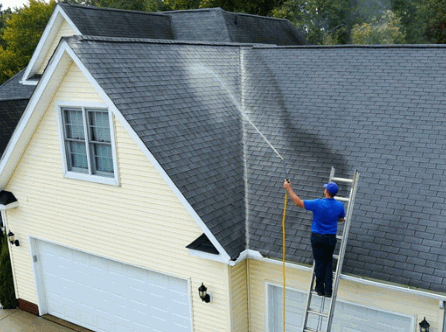
Chemical Cleaning
Chemical cleaning refers to the application of specialized cleaning solutions specifically formulated to break down and eliminate stubborn stains, mold, and debris from roofs without the necessity of high-pressure washing. This method can be particularly effective in scenarios where pressure washing might pose a risk of damage to roofing materials, making it a preferred alternative for homeowners focused on maintaining and extending the longevity of their roofs.
A variety of cleaning chemicals are utilized in this process, each engineered with specific ingredients to target different types of contaminants. Commonly employed solutions include:
- Algaecides: Effective in combating algae growth.
- Mildewcides: Designed to target and eliminate mold and mildew.
- Degreasers: Ideal for the removal of oily and greasy stains.
- Surfactants: Assist in lifting dirt and debris from surfaces.
These solutions are particularly advantageous in sensitive situations such as:
- When addressing delicate roofing materials like tiles or shingles.
- In areas where water runoff could potentially damage landscaping or exterior structures.
- To prevent roof deterioration caused by excessive pressure.
When utilizing these chemicals, it is essential to adhere to best practices, which include:
- Wear protective gear, including gloves and goggles.
- Ensuring proper ventilation when using aerosol products.
- Following manufacturer guidelines regarding application and dilution ratios.
By doing so, individuals can effectively utilize the benefits of chemical cleaning while minimizing any health or environmental risks.
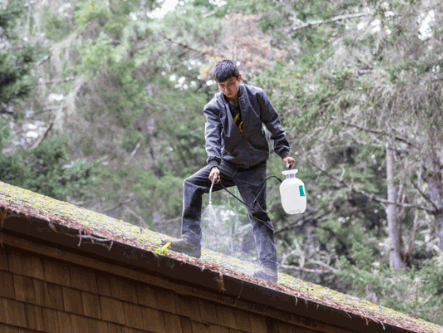
How Often Should You Pressure Wash The Roof?
Determining the appropriate frequency for pressure washing a roof is crucial for effective roof maintenance and the longevity of roofing materials. Homeowners should take into account several factors, including the local climate, the level of debris accumulation, and the presence of moss or algae when developing a cleaning schedule.
Conducting regular inspections can facilitate the identification of when pressure washing is warranted, enabling timely intervention to prevent potential damage.
Factors To Consider
Several key factors must be considered when determining the appropriate frequency for pressure washing a roof, including local weather patterns, the type of roofing materials, and the presence of organic growth such as moss or algae. Homeowners residing in humid areas may require more frequent washing due to the accelerated growth of mold and moss, while those in drier climates might experience less accumulation. A thorough understanding of these factors can assist homeowners in developing an effective maintenance schedule that preserves the integrity of their roofs.
The factors influencing the frequency of pressure washing extend beyond mere aesthetics; they have a significant impact on the longevity and durability of roofing systems. For instance:
- Local Weather Patterns: In regions characterized by high humidity, studies indicate that organic growth can increase by 50% within a few weeks. Consequently, experts recommend scheduling pressure washing every 6 to 12 months in such climates.
- Type of Roofing Materials: Different materials, such as asphalt shingles, metal, and tile, require distinct cleaning approaches. For example, asphalt shingles may necessitate annual cleaning due to their propensity to trap debris, whereas metal roofs can sometimes go two years without maintenance.
- Presence of Organic Growth: Homeowners should remain vigilant regarding visible moss or algae. Recent surveys suggest that roofs with such growth may experience a reduction in lifespan of 20% to 50% if corrective measures are not taken in a timely manner.
Understanding these intricate dynamics enables homeowners to make informed decisions, ensuring their roofs remain in optimal condition while potentially reducing the risk of costly repairs.
Signs That Your Roof Needs To Be Pressure Washed
Recognizing the signs that indicate the necessity for pressure washing your roof is essential for maintaining both its aesthetic appeal and functional integrity, allowing for timely intervention before more serious issues develop. Timely pressure washing can mitigate the risk of costly repairs by addressing minor problems before they escalate.
Homeowners should remain attentive to indicators such as visible stains, moss growth, and an overall dull appearance, as these suggest the accumulation of debris that could compromise the roof’s integrity.
- Visible stains on the roof surface may signify the presence of algae or mildew, both of which can deteriorate shingles over time.
- Moss growth can trap moisture, leading to rot and potential structural damage if not addressed in a timely manner.
- An overall dull appearance may indicate a significant buildup of dirt and contaminants, which could adversely affect the roof’s lifespan.
Neglecting these signs can result in severe consequences, including leaks or mold problems within the home. Regular roof inspections can facilitate the early detection of these signs, enabling the implementation of effective maintenance strategies and promoting the longevity of the roofing system. Engaging professional services ensures that the task is completed safely and thoroughly.
